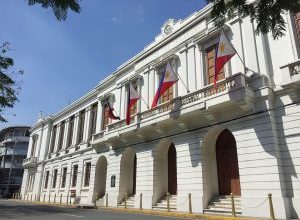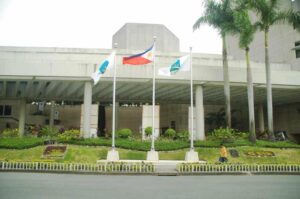BSP likely to mirror Fed’s ‘wait-and-see’ approach — analysts

By Keisha B. Ta-asan, Reporter
THE BANGKO SENTRAL ng Pilipinas (BSP) is expected to adopt a cautious approach on monetary policy this year, as it will likely wait for the US Federal Reserve to cut rates before starting to loosen policy.
This is after the US Federal Open Market Committee (FOMC) kept interest rates steady for the fourth straight meeting on Thursday. The target Fed funds rate is currently at the 5.25-5.5% range, after the Fed hiked by 525 basis points (bps) from March 2022 to July 2023.
However, US Fed Chair Jerome H. Powell at a news conference said policy easing is unlikely in March, dashing market expectations of rate cuts in the first quarter.
“The pause adds to the data we are looking at,” BSP Governor Eli M. Remolona, Jr. told BusinessWorld in a Viber message. “The statement was slightly more hawkish than before.”
While the decision of the US Fed to keep rates steady was widely expected, Mr. Powell revealed a cautious approach due to mixed economic data, Security Bank Corp. Chief Economist Robert Dan J. Roces said in a Viber message.
“This ‘wait-and-see’ stance by the Fed is likely to influence the BSP meeting on Feb. 15. Given the interconnectedness of global financial markets and the Fed’s impact on the peso, the BSP might adopt a similar cautious ap-proach,” Mr. Roces said.
China Banking Corp. Chief Economist Domini S. Velasquez in a Viber message said the Fed will likely deliver rate cuts around the middle or the second half of the year.
“Regarding the timing of monetary policy adjustments, we anticipate that the BSP will wait for the Fed to cut rates before initiating any easing measures. This approach aims to maintain interest rate differentials at their current levels, ensuring a balance for the stability of the Philippine peso,” she said.
ING Bank N.V. Manila Senior Economist Nicholas Antonio T. Mapa in an e-mail said any rate adjustments from the BSP will be based on the Fed’s own policy moves.
“Thus, we believe that any rate reduction over in the Philippines will only likely take place once the Fed begins its pivot. We believe that the BSP will be on hold in the first quarter and possibly also in the second quarter, de-pending on the Fed,” he said.
After hiking key policy rates by 350 bps in 2022, the Monetary Board tightened borrowing costs by another 100 bps throughout 2023, which brought the key rate to 6.5%, the highest in 16 years.
Mr. Remolona earlier said he does not see any possibility of a rate cut in the first half of the year, and there is still room to raise interest rates amid risks to inflation and robust economic growth.
The first rate-setting meeting of the seven-member Monetary Board is scheduled on Feb. 15.
“The (BSP’s) decision will involve balancing the Fed’s position, future signals, and domestic factors like inflation and growth,” Mr. Roces said.
Mr. Roces said the Fed may consider policy easing in the second half of 2023 to support growth in the US economy.
However, the BSP will prioritize the country’s inflation dynamics first in determining the extent of its own rate adjustment, Ms. Velasquez said.
“As the BSP’s risk-adjusted inflation expectations for 2024 remain above the 4% target, it is likely that BSP rate cuts will be minimal throughout the year. Our base case scenario suggests the possibility of two rate cuts, with a potential for three if inflation slows down more rapidly than anticipated,” she said.
The BSP sees headline inflation averaging 3.7% this year, lower than the 6% average in 2023, before easing to 3.2% in 2025.
Should risks materialize, the BSP’s risk-adjusted forecasts show that inflation could settle above the 2-4% target, or at 4.2%, this year. For 2025, the BSP’s risk-adjusted inflation forecast is at 3.4%.
Meanwhile, ING’s Mr. Mapa said the Fed may begin to cut borrowing costs as early as May.
“We believe the BSP should consider rate cuts shortly after to help shore up flagging growth momentum,” he said.
The Philippine economy grew by 5.6% in 2023, slower than the 7.6% expansion in 2022 and falling short of the government’s 6-7% target.
The government is targeting 6.5-7.5% gross domestic product (GDP) growth this year.
“The 2023 GDP growth was indeed positive but failed to hit the downwardly revised growth target for the year, highlighting the early impact of policy tightening carried out by the BSP,” Mr. Mapa said.
He cited earlier remarks from Mr. Remolona, who said the full impact of the BSP’s aggressive tightening will likely be felt this year.
“Given that policy rate hikes have only a marginal impact on fighting off supply side inflation, the inflation we are seeing in the Philippines today, we believe the proper response for the BSP would be to allow supply-side measures to be rolled out by fiscal authorities while at the same time provide a fostering environment for long-term structural reform,” he said.
Mr. Roces said even though the Fed’s actions will influence the BSP, the Monetary Board will focus on the domestic economic situation.
“If the Fed eases in the second half, creating more favorable global conditions, and if Philippine data allow for it, the BSP will ease policy to promote growth while managing inflation. But the timing and extent of such adjust-ments will depend on how economic scenarios unfold globally and locally,” he added.




